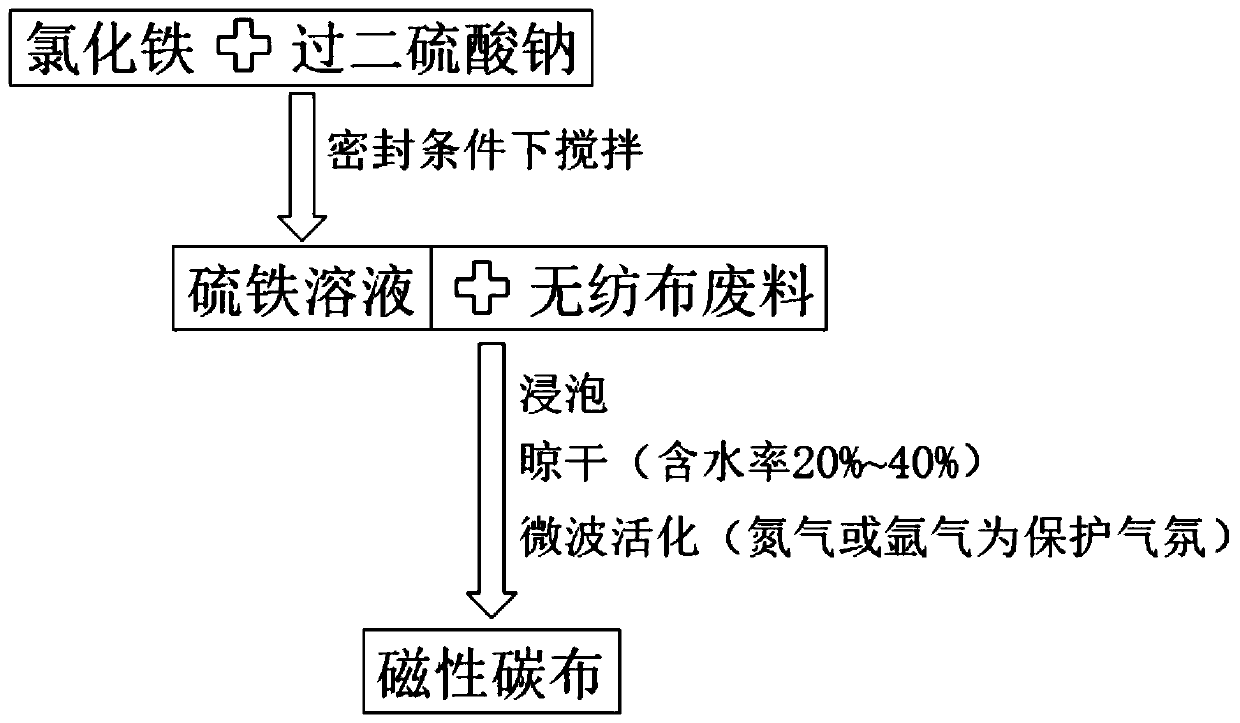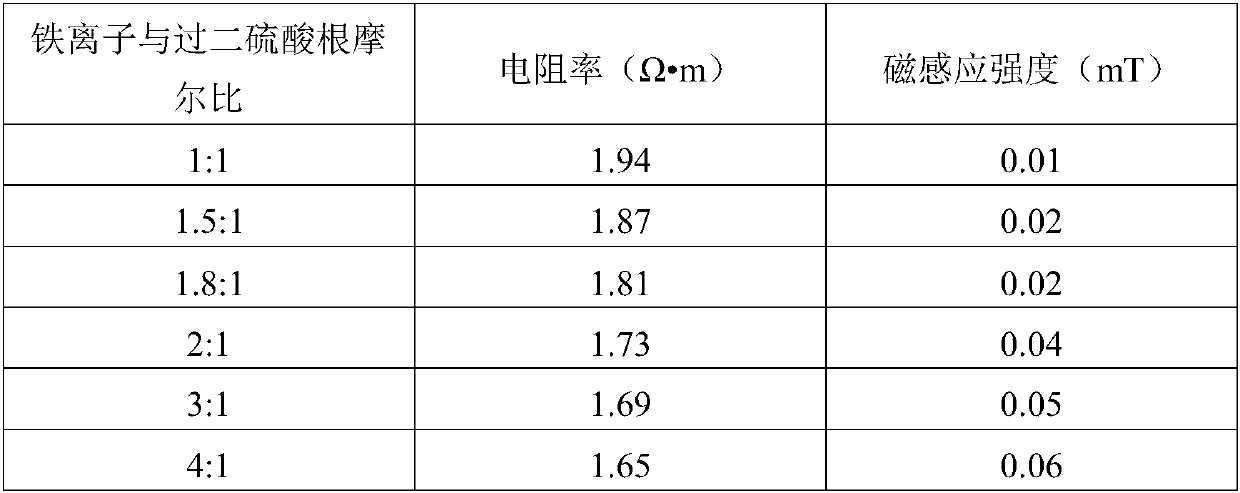Method for preparing magnetic carbon cloth by utilizing non-woven fabric waste, magnetic carbon cloth prepared through method and application of magnetic carbon cloth
A non-woven, magnetic technology, used in textiles and papermaking, fiber types, radiation wave/microwave fiber processing, etc., can solve the problems of complex process, high ash content of carbonized materials, and increased cost, and achieves wide range of sources and preparation operations. Simple process and effective utilization
- Summary
- Abstract
- Description
- Claims
- Application Information
AI Technical Summary
Problems solved by technology
Method used
Image
Examples
Embodiment 1
[0028] Embodiment 1 The influence of the molar ratio of iron ion and peroxodisulfate radical on the resistivity and magnetic induction of magnetic carbon cloth
[0029] According to the molar ratio of iron ion and peroxodisulfate 1:1, 1.5:1, 1.8:1, 2:1, 3:1, 4:1, 5:1, 5.2:1, 5.5:1, 6:1 respectively Weigh ferric chloride and sodium peroxodisulfate, dissolve them in water at the same time, stir under sealed conditions until the ferric chloride and sodium peroxodisulfate are completely dissolved, and prepare a ferric sulfur solution composed of ferric chloride and sodium peroxodisulfate. The concentration of peroxodisulfate in iron sulfur solution is 0.01M. The non-woven fabric used in this example is polypropylene non-woven fabric. According to the solid-liquid ratio of 1:1 mg / mL, the polypropylene non-woven fabric is immersed in the corresponding iron sulfur solution, soaked for 30 minutes under sealed conditions, and then the polypropylene non-woven fabric is taken out. The s...
Embodiment 2
[0035] Influence of peroxodisulfate concentration on the resistivity and magnetic induction intensity of magnetic carbon cloth in the iron sulfur solution of embodiment 2
[0036] Weigh ferric chloride and sodium peroxodisulfate respectively according to the molar ratio of iron ion to peroxodisulfate 5:1, and then dissolve them in water at the same time, and stir under sealed conditions until ferric chloride and sodium peroxodisulfate are completely dissolved. Iron sulfur solution composed of iron oxide and sodium peroxodisulfate. The concentration of peroxodisulfate in iron sulfur solution is 0.005M, 0.007M, 0.009M, 0.01M, 0.03M, 0.05M, 0.052M, 0.055M, 0.06M, respectively. The non-woven fabric of the present embodiment is a viscose fiber non-woven fabric. According to the solid-to-liquid ratio of 1: 1.5 mg / mL, the viscose fiber non-woven fabric is immersed in the corresponding iron sulfur solution, and soaked for 45 minutes under sealed conditions, and then Take out the visc...
Embodiment 3
[0041] Example 3 Effect of Microwave Power on the Resistivity and Magnetic Induction of Magnetic Carbon Cloth
[0042] Weigh ferric chloride and sodium peroxodisulfate respectively according to the molar ratio of iron ion to peroxodisulfate 5:1, and then dissolve them in water at the same time, and stir under sealed conditions until ferric chloride and sodium peroxodisulfate are completely dissolved. Iron sulfur solution composed of iron oxide and sodium peroxodisulfate. The concentration of peroxodisulfate in iron sulfur solution is 0.05M respectively. The non-woven fabric of this embodiment is an acrylic non-woven fabric. According to the solid-to-liquid ratio of 1:2 mg / mL, the acrylic non-woven fabric is immersed in the corresponding iron sulfur solution, and soaked for 60 minutes under sealed conditions, and then the acrylic non-woven fabric is taken out. Allow to dry until its moisture content is 40%. The acrylic non-woven fabric is activated by microwave, the microwave...
PUM
| Property | Measurement | Unit |
|---|---|---|
| electrical resistivity | aaaaa | aaaaa |
| magnetic flux density | aaaaa | aaaaa |
| electrical resistivity | aaaaa | aaaaa |
Abstract
Description
Claims
Application Information
 Login to View More
Login to View More - R&D
- Intellectual Property
- Life Sciences
- Materials
- Tech Scout
- Unparalleled Data Quality
- Higher Quality Content
- 60% Fewer Hallucinations
Browse by: Latest US Patents, China's latest patents, Technical Efficacy Thesaurus, Application Domain, Technology Topic, Popular Technical Reports.
© 2025 PatSnap. All rights reserved.Legal|Privacy policy|Modern Slavery Act Transparency Statement|Sitemap|About US| Contact US: help@patsnap.com



